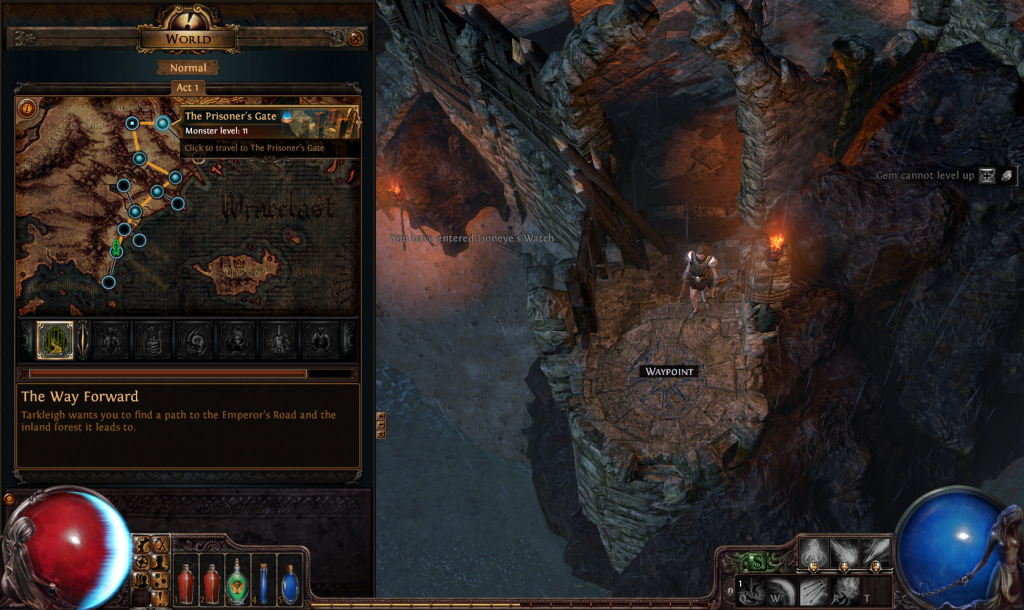Writing Flavour Text for your Game
- Edwin McRae
How to write flavor text.
At it’s most basic, flavor text does what it says on the label. It adds flavor to the items and interactive paraphernalia of your game. Take this tasty piece that accompanies grenades in Blood Dragon.
“Also known as the Island of Spice, this beautiful Caribbean island is a global destination for tourists. Wait, that's Grenada the country. Grenades, on the other hand, explode. You f**king throw them and yell something dumb like "Grenade out!" And then they blow up.”
Very droll and it perfectly establishes the pithy attitude of a game like Blood Dragon. A brutal satire of FPS games and 80s action movies.
But flavor text can actually do a lot more than that. Like tomes, they can provide gameplay hints whilst also enhancing your player’s understanding and emotional investment in your game world.
The Baleful Gem - Path of Exile
![]()
“The withering glare of corruption, made corporeal and pellucid in crystal.”
If done right, flavor text should be a Russian doll. Or an onion. Layers, donkey! To see what I mean, let’s unwrap that Baleful Gem text.
Firstly, there’s a gameplay hint in ‘withering’. This gem, when combined with another item, Maligaro’s Spike, can be used against the roots of a giant tree that cover the entrance to an ancient ruin the player must access in order to progress. The gem will kill the tree, literally ‘wither’ it away.
Secondly, there’s the reference to ‘corruption’. I’m not going to spoil this one for you as it’s one of the ‘big reveals’ in Path of Exile. Suffice to say that corrupting energies permeate Wraeclast, the continent upon which Path of Exile is set. Understanding corruption’s effect, and its source, is vital to unravelling the story of Wraeclast, its post-apocalyptic state, and why certain powerful people are so interested in the place.
Finally, ‘made corporeal and pellucid in crystal’ is an inference to another gameplay element in Path of Exile. Virtue gems. It’s a clue to the fundamental nature of virtue gems, how they work and where they come from.
So hopefully you can see just how powerful flavor text can be as a storytelling device. If the story of your game were a murder mystery, flavor text would be the suspect who insists they didn’t knife the victim before the detective even mentions that stabbing was the cause of death. Every line should be a riddle that the player can solve, if they put their mind to it. And trust me, players will strive to work this stuff out. There are whole Reddit threads devoted to the musings and theories of PoE players as they debate the meanings of item flavor texts. While only 20% of your gamer community will likely be lore-junkies, they’re a devoted and energetic minority. And 20% of millions of players...that’s still a lot of people.
Flavor texts need not work in isolation, either. While this is particularly pertinent to item-rich RPGs, any game that features sets of virtual collectables can create something I call ‘Suits of Meaning’.
 At its most literal, this is a suit of armor comprised of boots, greaves, gauntlets, a breastplate and helmet. Let’s throw in a ring and a medallion for good measure. And let’s say that this complete kit belonged to a historical figure within the game world. I’ll use a character I created for Bloodgate: Age of Alchemy as an example.
At its most literal, this is a suit of armor comprised of boots, greaves, gauntlets, a breastplate and helmet. Let’s throw in a ring and a medallion for good measure. And let’s say that this complete kit belonged to a historical figure within the game world. I’ll use a character I created for Bloodgate: Age of Alchemy as an example.
Pyre's Cowl "All I want to do is bring a little warmth to this land." - Lord Pyre
Pyre's Cuirass "It's a curious fact that human fat is highly flammable." - Lord Pyre
Pyre's Brassards "Fire's not the sort of lover you can hold hands with." - Lord Pyre
Pyre's Way "I've not met a roadblock that a good fire couldn't rectify." - Lord Pyre
Pyre's Light "No need to fear the dark. I'll light your way." - Lord Pyre
Pyre's Medal "When the army's away, someone has to keep the homefires burning." - Lord Pyre
Yes, Lord Pyre is a pyromaniac, something that is hinted at in each line, and is overwhelmingly conclusive once all of the lines are put together. Note that he’s also an unashamed pyromaniac, convinced that his arsonist ways are somehow justified, even righteous.
Now the player has the option of donning Lord Pyre’s armor, and by doing so, wearing the very character of this noble firebug. It’s hard not to feel like ‘the righteous, cleansing flame’ when encased in a suit of meaning like that.
On the flip side, the Lord Pyre set can be used to establish our connoisseur of conflagration as an antagonist, a Level Boss perhaps. One who might be rather miffed to see an imposter strutting about in his beloved kit. In six lines we’ve established a villain. And as the saying goes, ‘better the Devil you know’. Boss kills are so much more satisfying when you actually know the guy you’re taking down.
Flavor Texts need not be limited to items either. They can festoon any number of interactive elements in your game. Take warp points on a map, for instance. In Path of Exile, you can warp into various areas from the hub, an Act Town in this case.

Each warp point has a line or two of flavor text.
Mudflats - “Mud and air seethe with warped life.”
The Ship Graveyard - “Whispered agonies of the marooned dead.”
Fellshrine Ruins - “The ground aches with desecration. The rain tastes of blight.”
These flavor texts add extra layers of atmosphere to an area, layers that can’t be done with in-game assets. You can’t ‘taste’ the rain in Wraeclast, nor can you feel ‘seething’ or ‘aching’ beneath your feet. Flavors like these supplement the visual and audio expressions of the game with other senses that can’t otherwise be expressed in an isometric ARPG made for the PC.
Area flavor texts can also provide historical context to a virtual environment.
Ancient Pyramid - “Two thousand years of regret.”
The Docks - “Life pales in the wake of progress.”
The Scepter of God - “The taller the tower, the greater the fall.”
These areas are all sites of past tragedies. The first and last refer to the fall of empires due to the ambitious follies of their leaders. The middle one is about slavery and the dehumanizing effects of industrialization.
The intention is to create that sense of history one feels when you enter a real-world landmark, like when I walked the cobbled streets of Rome and had the bizarre sense that my sneakered feet were walking on the same stones that had borne the marching sandals of Roman Legionnaires.
You can even add flavor text to under-the-hood game elements like skill trees. Specific character builds in Path of Exile now have names and flavour text.
Ranger Class: Deadeye
“A woman can change the world with a single, well-placed arrow.”

It reflects both a philosophy about how the game world works and a preferred style of gameplay that favors long-ranged weapons and accuracy over everything else. Meaning and mechanics, working together to deepen the player experience.
But how do you create good flavor texts? How do you forge lines that resonate, that carry a far weightier meaning than their few words would imply?
Hire a poet!
Or at least make sure your narrative designer has had some experience in poetry or songwriting. If they haven’t then it’s about time they had a go.
And I can tell you one easy way to utterly screw up your flavor texts, and that’s to just ‘write something that sounds cool’. This is a trap I’ve seen many developers fall into, and to be perfectly honest, it’s usually because there’s a game designer (who writes in their spare time) doing the work. It takes years of practice for a poet to be able to write lines that feel like the tip of an iceberg, like those few words allude to something large, looming and deeply engaging. Writing stuff that ‘sounds cool’ leads to lines that make no sense upon closer inspection, and after a hundred or so items, flavor texts that all sound pretty much the same.
“With staff in hand and wrath in heart, your soul and corpse shall surely part.”
Wait, is that if I hold a staff in my hand while I’m angry? Is there something wrong with that staff? Will my anger trigger some sort of terrible chain reaction that’ll blow my arm off and cause me to bleed to death. Oh wait, the flavor text is on something called ‘The Dark Mage’. So is it this shadowy wizard, this sable sorcerer, this clouded conjurer, this ebony enchanter going to smite me with that staff if I make him mad? And hang on, isn’t my body a corpse only after the soul has left it. Isn’t it just a ‘body’ before that?
Honestly, I don’t know. So confused right now. But hey...it sounds cool!
So here are a couple of ways you can avoid both the nonsensical and samey pitfalls of flavor text writing.
Theme your items. If you have a set of items that are designed to belong to the Maraketh culture in your game, a race of nomadic Mongolian/Japanese warrior women who ride about on two-legged dinosaur/bird things, then make sure your flavor texts also reflect that. Have a look at ancient Mongolian and Japanese sayings and proverbs. Get a feel for how they are written, what imagery they use, and what spiritual references they tend to make. Then emulate that style whilst referring to the lifestyles, goddesses, and philosophies that are important to the Maraketh. Use the flavour texts to help build the player’s understanding of this fictional culture they’re interacting with.
Refer to specific figures and events in your game world. You can’t go far wrong if you are dealing with characters and historical happenings that have been well thought out and are part of your existing canon.
Thousand Ribbons Robe
![]()
“The night of a thousand ribbons,
To remember the day of a thousand flames,
When Sarn burned,
And was born again.”
The above item and flavor text refers to the night that Sarn, the capital of the Eternal Empire in Wraeclast, suffered a fire that destroyed much of the city and killed thousands of people.
I really can’t rate flavor text highly enough in adding story to your game at minimal cost. You need go no further than ‘Winter is coming’ to appreciate the sheer weight of meaning that just three words can bare.

So let me leave you with some golden rules for writing flavor text.
- All flavor text must be consistent with the lore of your game.
- To help with continuity between flavor texts, have one writer in charge of it. One person who oversees every line, even if multiple writers are producing them.
- If it doesn’t mean anything, if it’s just there to sound cool, then don’t use it.
- Flavor text is poetry, not prose. Make every word count.
Flavor text is flavorsome. It’s there to whet your player’s appetite and make them hungry to understand your game world.
Be sure it’s on the menu and please make it tasty!
And if you'd like to go deeper on flavor text and a whole bunch of other narrative design techniques, I have a handy little book on the subject.
Thanks for reading. :-)
Edwin

About Edwin McRae
Edwin is a narrative consultant and mentor for the games industry.
